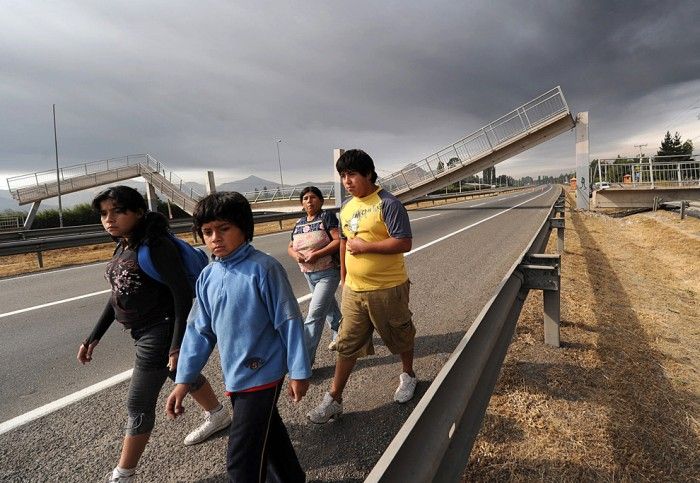|
|
Earthquake In Chile, South America
|
This is so because the energy released in an earthquake, and thus its magnitude, is proportional to the area of the fault that ruptures and the stress drop. Therefore, the longer the length and the wider the width of the faulted area, the larger the resulting magnitude. The topmost, brittle part of the Earth’s crust, and the cool slabs of the tectonic plates that are descending down into the hot mantle, are the only parts of our planet which can store elastic energy and release it in fault ruptures. Rocks hotter than about 300 degrees Celsius flow in response to stress, they do not rupture in earthquakes. The maximum observed lengths of ruptures and mapped faults, which may break in one go are approximately 1000 km. Examples are the earthquakes in Chile, 1960; Alaska, 1957; Sumatra, 2004, all in subduction zones. The longest earthquake ruptures on strike-slip faults, like the San Andreas Fault (1857, 1906), the North Anatolian Fault in Turkey (1939) and the Denali Fault in Alaska (2002), are about half to one third as long as the lengths along subducting plate margins, and those along normal faults are even shorter.
The most important parameter controlling the maximum earthquake magnitude on a fault is however not the maximum available length, but the available width because the latter varies by a factor of 20. Along converging plate margins, the dip angle of the rupture plane is very shallow, typically about 10 degrees. Thus the width of the plane within the top brittle crust of the Earth can become 50 to 100 km (Tohoku, 2011; Alaska, 1964), making the most powerful earthquakes possible.
Strike-slip faults tend to be oriented near vertically, resulting in an approximate width of 10 km within the brittle crust, thus earthquakes with magnitudes much larger than 8 are not possible. Maximum magnitudes along many normal faults are even more limited because many of them are located along spreading centers, as in Iceland, where the thickness of the brittle layer is only about 6 km.
In addition, there exists a hierarchy of stress level in the three fault types. Thrust faults are generated by the highest, strike slip by intermediate, and normal faults by the lowest stress levels. This can easily be understood by considering the direction of the greatest principal stress, the direction of the force that ‘pushes’ the rock mass during the faulting. In the case of normal faults, the rock mass is pushed down in a vertical direction, thus the pushing force (greatest principal stress) equals the weight of the rock mass itself. In the case of thrusting, the rock mass ‘escapes’ in the direction of the least principal stress, namely upward, lifting the rock mass up, thus the overburden equals the least principal stress. Strike-slip faulting is intermediate between the other two types described. This difference in stress regime in the three faulting environments can contribute to differences in stress drop during faulting, which contributes to differences in the radiated energy, regardless of fault dimensions.
|
|









